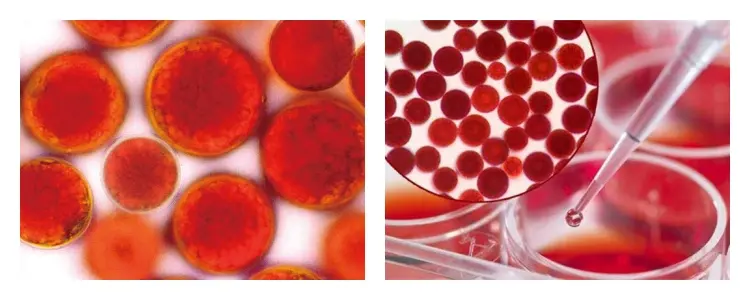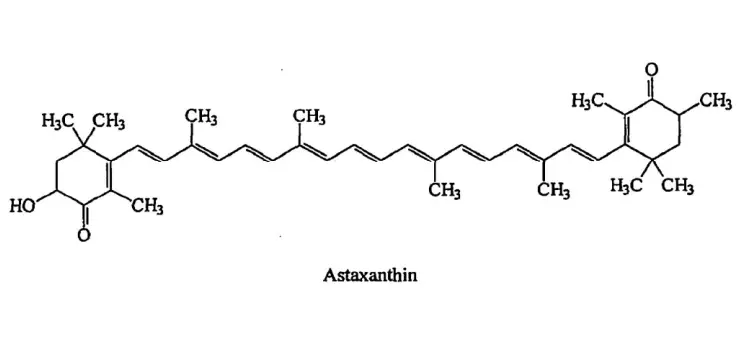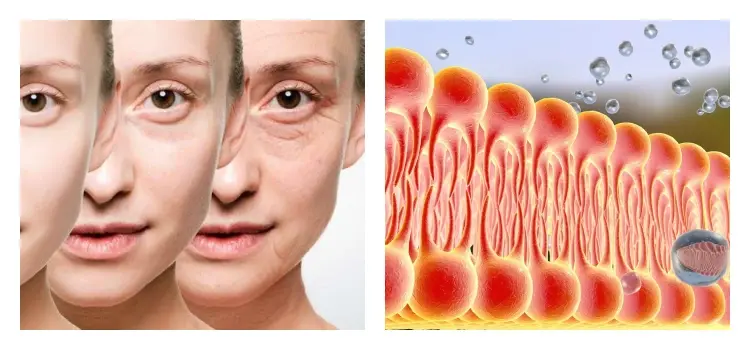What are the benefits of astaxanthin?
2024-08-14 10:45:20
What are the benefits of astaxanthin?
What Is Astaxanthin?
Astaxanthin, also known as astaxanthin or ASTA, is mainly found in marine organisms, such as crustaceans, fish, and shellfish. In addition, some plants also contain a small amount of astaxanthin, such as pumpkin and tomatoes. It has an antioxidant effect, can remove free radicals in the body, and protect cells from oxidative damage. At the same time, it can also enhance immunity, promote the body's metabolism, and help maintain good health.
It is a red carotenoid, the highest level product of carotenoid synthesis, and belongs to keto-biochrome. Its chemical structure is similar to that of β-carotene, and its chemical name is 3,3′-dihydroxy-4,4′-diketo-β,β′-carotene. It is a red solid powder, fat-soluble, insoluble in water, and soluble in organic solvents. Astaxanthin is called "super vitamin E" and its ability to capture free radicals is more than 10 times higher than that of β-carotene and more than 100 times stronger than vitamin E.

Astaxanthin is a chain-breaking antioxidant with extremely strong antioxidant and anti-aging effects. It can remove nitrogen dioxide, sulfide, disulfide, etc., and can also reduce lipid peroxidation, effectively inhibiting lipid peroxidation caused by free radicals. Astaxanthin has a strong antioxidant capacity. With heme protein containing ferrous ions as the free radical generator and linoleic acid as the acceptor, the dosage ratio of various carotenoids and their derivatives and tocopherol (VE) to remove free radicals is detected.
Astaxanthin is also a natural antioxidant, which has a good effect on beauty and slowing down human aging. However, it is not very stable, easy to oxidize and decompose in the light, and its activity is mostly retained in the form of astaxanthin gel on the market. It has broad application prospects in health products, medicine, cosmetics, food additives and aquaculture.

Astaxanthin Extraction Source
Astaxanthin is mainly derived from algae, bacteria, phytoplankton, etc. Astaxanthin in nature is usually extracted from Haematococcus pluvialis. When Haematococcus pluvialis is subjected to harsh environmental stress, the cells will accumulate a red substance, namely astaxanthin. In addition, astaxanthin can also be obtained from crustaceans, fish, birds, poultry and other organisms, because these organisms have long eaten algae, bacteria and phytoplankton containing astaxanthin, making their skin and feathers appear red.

What are the functions of astaxanthin?
Antioxidant
Astaxanthin is a natural active ingredient, which has strong antioxidant properties. After the human body absorbs this substance, it can synthesize carotene, lutein, canthaxanthin and other elements, which can effectively inhibit the occurrence of oxidation reactions in the human body, and can remove free radicals in the human body, reduce their damage to cell tissues, help anti-oxidation and anti-aging, prevent photoaging, repair skin, and keep the human body healthy and young.
Anti-inflammatory
Astaxanthin can inhibit a variety of inflammatory factors, help reduce inflammatory reactions, and have a certain auxiliary therapeutic effect on some diseases caused by inflammation. The strong antioxidant properties of astaxanthin help inhibit free radicals and reduce the oxidative damage of free radicals to joints, avoid inflammation, and thus exert anti-inflammatory effects.
Enhance immunity
Astaxanthin can promote the production of antibodies by spleen cells, enhance the role of immune T cells, and improve the body's immune function. It stimulates the production of immunoglobulins in the body and has an important immunomodulatory effect.
At the same time, astaxanthin can fight against free radicals released by muscles during exercise, reduce the oxidative effect of free radicals on muscle tissue, thereby reducing muscle soreness caused by exercise and reducing fatigue in the body.
Protect eyesight
After being absorbed by the human body, astaxanthin can be converted into vitamin A and carotene, which will be transported to the retina to synthesize rhodopsin to the greatest extent, improving the human eye's ability to adapt to the dark. In addition, if people take some astaxanthin in moderation, it can also relieve eye fatigue, improve human visual sensitivity, and effectively prevent vision loss.
Whitening and spot removal
Astaxanthin’s strong antioxidant property makes it a potential photoprotectant, effectively removing free radicals that cause skin aging, protecting cell membranes and mitochondrial membranes from oxidative damage, and preventing skin photoaging.
Astaxanthin can effectively inhibit melanin and reduce the precipitation of melanin.
Protect the liver
Astaxanthin can protect vitamin A and enhance the active factors of cells, which can promote the activity of liver cells and enhance their detoxification effect.
Color enhancement
Astaxanthin can be used as a color enhancer for aquatic animals such as shrimp, crab, and fish. Crushing shrimp shells and shrimp meat and feeding them to goldfish can also enhance color.

Can astaxanthin really be an antioxidant?
Astaxanthin does have antioxidant effects. The active electronic effects such as conjugated double bonds, hydroxyl groups and unsaturated ketone groups in the molecular structure of astaxanthin can attract free radicals or provide electrons to free radicals, thereby achieving the purpose of removing free radicals. This is the core mechanism of its antioxidant effect.
A large number of studies have shown that astaxanthin performs well in quenching singlet oxygen, removing hydroxyl radicals, superoxide anions and other free radicals. Its antioxidant activity far exceeds that of other carotenoids, such as lutein, β-carotene, etc., and is even known as "super vitamin E".
Astaxanthin can protect cells from oxidative damage by reducing the accumulation of free radicals in the body, thereby delaying aging and preventing chronic diseases such as cancer and atherosclerosis.
Astaxanthin can reduce the damage of ultraviolet rays to the skin, inhibit the production of melanin, and prevent the formation of spots and wrinkles. At the same time, it can also promote collagen synthesis, increase skin elasticity, and make the skin smoother and firmer.
It can also penetrate the cell membrane, effectively prevent retinal oxidation, reduce free radical damage to the retina, and thus protect vision health.
Astaxanthin regulates the immune system, enhances the body's resistance, and reduces the incidence of infection and disease. This is closely related to its antioxidant effect, because antioxidants can reduce inflammatory responses and oxidative stress damage in the body.
In summary, astaxanthin is indeed a natural substance with strong antioxidant capacity, which performs well in protecting eyes, improving skin, and enhancing immunity. However, when using it, you also need to pay attention to the principle of moderation and individual differences.

What is Astaxanthin Used For?
Food
As a food additive, astaxanthin can not only be added to food as an immune enhancer, anti-aging agent and other functional ingredients, but also effectively preserve freshness, color, taste and quality, as a food colorant, antioxidant, etc. It is used to keep the original nutrients of the food from being damaged or to improve the sensory properties, and enhance the attractiveness of the food to consumers.
Astaxanthin has extremely strong antioxidant activity and can efficiently remove oxygen free radicals. Therefore, adding astaxanthin to functional foods can help prevent a series of health problems caused by organ aging.
Cosmetics
Astaxanthin is also increasingly used in the cosmetics field. With its unique molecular structure, natural astaxanthin can efficiently quench free radicals caused by ultraviolet rays, prevent skin photoaging, eliminate harmful free radicals in cells to the maximum extent, delay cell aging, reduce skin wrinkles, reduce melanin deposition, reduce freckles, retain moisture, and make the skin more elastic, tense and moisturized. Due to its powerful antioxidant and anti-inflammatory effects, astaxanthin is added to many cosmetics, such as creams, essences, etc., to help improve skin problems and delay skin aging.
Medicine
Astaxanthin is also widely used in the medical field. It can be used to make anti-inflammatory drugs. Studies have shown that astaxanthin has anti-inflammatory effects and can improve inflammation.
Astaxanthin's antioxidant and immune-boosting effects can be used to make drugs to prevent oxidative tissue damage. Studies have shown that astaxanthin can pass through the blood-brain barrier, protect the nervous system, and effectively prevent retinal oxidation and photoreceptor cell damage.
If you would like more information, please contact sales@sxytorganic.com
_1737093401309.png)
